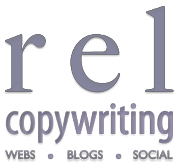Basics of blogging
 Thursday, May 13, 2010 at 12:52PM |
Thursday, May 13, 2010 at 12:52PM |  robin ellen lucas |
robin ellen lucas | Are you new to blogging? Have you been advised to start your own blog and don't know where to start?
Maybe you have some experience with web design and wonder how blog design differs. Maybe you have been blogging as a user for some time but someone else set up the site for you.
Here are the basics....
First of all, it is free to set up a blog site. There are well-known blogging tool applications out there such as Blogger (owned by Google) and Wordpress. Blogger is the simpler tool of the two. For those looking for many bells and whistles, Wordpress is the answer.
The blogging tool applications will first ask you for some basic setup details such as your name and email address. You then need to chose your blog site address. There is a search tool within the blog tool application that will assist you in determining whether or not your desired site is available or not.
Some blog tool applications, such as Blogger and Wordpress, hardcode part of the blog site address into your new address (e.g., .blogspot.com, .wordpress.com). With Wordpress, there is a 4-character length requirement at first and then you apply for an upgrade later to change it if you desire. After your blogsite has been created you log on to create a profile, upload a picture, create a paragraph about you, etc. The basic template is provided so you can't possibly get lost.
After your blogsite has been created you log on to create a profile, upload a picture, create a paragraph about you, etc. The basic template is provided so you can't possibly get lost.
You will then need to decide about the layout. There are templates provided with basic layouts with regards to location of your picture, the blog text and column for your "widgets". Widgets are specific applications you run on your blog. Typical examples are a Twitter feed, List of your favorite books, Category list with counts, Favorite links. After choosing your overall layout, you have the control over the order of your "widgets" as well as which ones you display.
The templates are pre-built with certain color schemes, but most blog tool applications offer an easy way to modify the colors if you chose. With Blogger, this is easily done. With Wordpress, you need to pay extra in order to have access to the customization functions. In setting colors, first you need to know that each color on a blog, as is true for a website, is indicated by a 6 character string of numbers and letters.
You can locate the color you desire by going to a website where you like the color and viewing the page source, searching for "color" to find the codes. Or, you can use the color template that comes with the blog tool application to generate that code for you. You will have the chance to change background color, text color, link highlight color, and many others.
Behind the scenes, the blog sites are run using HTML, as websites. Although it is not required to know the HTML to set up a blog, since the blog tool application provides you with a graphical interface, it is possible to edit the HTML if you are HTML-savvy. One reason I found it necessary to edit the HTML was to add a Google Analytics script so that I could get a nice report of who visits my blog, where they go on the blog, and how long they stay there. Aside from the layout, you'll have other decisions to make such as the number of blog articles you'd like to show on your main page. Some people list 5 so that there are many previous articles lined up next for the readers. Others chose only 1, preferring that the readers utilize the category list and archive list for more reading. It is up to you.
Aside from the layout, you'll have other decisions to make such as the number of blog articles you'd like to show on your main page. Some people list 5 so that there are many previous articles lined up next for the readers. Others chose only 1, preferring that the readers utilize the category list and archive list for more reading. It is up to you.
Your readers will want to leave you comments so you have the choice on who has permissions to do this, and whether or not you would like to monitor these posts before they become live on your site. There are other decisions to make too that are all laid out in the blog tool. Pretty self-explanatory.
When you are ready to start writing your first blog, aside from knowing the text you will write, and the pictures or videos you will upload, you need to think about Categories. These are sometimes referred to as Tags or Labels in various blogs on the internet. In Blogger, they are called Labels behind the scenes but you can change the name as you desire. In Wordpress, there are Categories to describe the general subject of the blog, and Tags as well to get into more detail.
The Categories/Tags are your chance to setup sub-categories to your articles which can be used over and over again so that your readers have a better way to sort through all of your blog articles. The Categories/Tags can be one word or phrases. Some writers prefer to have only a few category phrases, and poets prefer to have many one-word tags to create imagery of their work. It's up to you to decide. The way you display your Categories/Tags is setup in the Layout section. You can, for example, have an alphabetized bullet point list of categories with counts listed. Or you can chose to more artistically display your Categories/Tags using a "cloud" functionality which change the Category/Tag font size depending on the count (see picture to the right where each word is a "category"). Again, this is up to you to decide.
The way you display your Categories/Tags is setup in the Layout section. You can, for example, have an alphabetized bullet point list of categories with counts listed. Or you can chose to more artistically display your Categories/Tags using a "cloud" functionality which change the Category/Tag font size depending on the count (see picture to the right where each word is a "category"). Again, this is up to you to decide.
Your entire catalog (or archive) of blog posts will be displayed in the column of your layout where you display "widgets". You can chose to have your archives displayed by Month, by Week, by Day, as well as the formatting of the dates. You can also chose to have a drop-down list so that your readers select what they would like to see.
Once you start writing your blog article, you have the option of saving the draft copy often, deciding which date and time to post, as well as the format of the date. When you are all set, it is a good idea to proofread your work using the preview tool. When you are all set you Publish!
Since the final published article may look a bit different from the previewed version, it is sometimes necessary to edit once you do your final post. This is allowable. But remember, whenever you post, you may be sending an email to all of your subscribers. Note: with Blogger, you need to specifically enter email addresses of those who you'd like to have receive the email notifications. With Wordpress, all subscribers have the chance to set their notification preferences for frequency of receiving your blog posts.
Part of your layout will include a section for Followers/Subscribers and a place for the Followers to subscribe to your blog via email.
Don't forget to spread the news of your blog by sending out your new blogsite to your friends, and posting it where you see fit. You can also link it to your website by giving the blogsite to your web designer.
I will be writing a more detailed blog in the future to follow up to this one.
Good luck blogging!
© 2010 R.E.L. Copywriting







Reader Comments